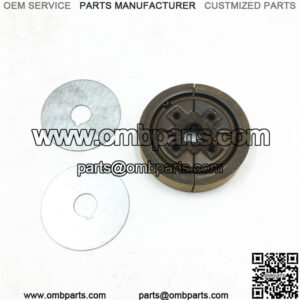How a centrifugal clutch works
As we have learned even since we were little children in playground roundabouts, when a mass is rotating/spinning there’s a force that is generated and pointing away from the axis of rotation called centrifugal force. The faster the rotation becomes, the stronger this force gets, and this is why it is so hard to stay on roundabouts that spin fast.
The operation of the centrifugal clutch is based exactly on the generation of this centrifugal force. More specifically, the rotating shaft is connected to the crankshaft of the engine and is placed in the center of the clutch. The outer casing/housing is positioned concentrically and is connected to the driven shaft. As the engine RPMs increase, the speed of rotation of the driving shaft increases, forcing the shoes that are installed on the inner side of the assembly to extend and reach out to the inner wall of the drum. Both the inner side of the drum and the outer side of the shoe are made of high friction materials so there can be a reliable engagement, similar to brakes. However, this also causes high temperatures when the engage/disengage action is more often than intended.
Once the engine RPMs drop down again, the clutch will immediately disengage so the driven shaft will no longer receive rotational motion energy. This helps prevent engine stalling when the load is overwhelming and the engine is having trouble to cope with it, and also makes the overall operation safe for both the systems and the user.
Pros and Cons
The advantages of using a centrifugal clutch are:
- It is easier for the user/driver since the operation becomes simpler.
- It is safer for both the user and the systems since huge loads won’t stall the engine and letting the throttle free disengages the driving shaft almost immediately.
- Centrifugal clutches are usually the cheaper choice among the various clutch types available in the market.
- If optimized in conjunction with a particular engine, the overall operation can become extremely efficient and effective.
However, there are also several disadvantages of choosing a centrifugal clutch, the most important of which are:
- Heat generation is a constant issue due to the friction between the drum and the shoes. If taken too far due to bad driving/usage habits, permanent heat damage may completely destroy the clutch.
- There is a need for frequent oiling of the centrifugal clutch arrangement so as to keep the temperature at a safe level.
- Improper installation of the centrifugal clutch can result in its failure as quickly as in a couple of minutes. Still though, even if installed properly, it won’t last more than five years maximum.
- Sand and dust particles or other kinds of aerial impurities can easily penetrate and enter the centrifugal clutch arrangement, changing its shoe-drum friction properties, causing unpredictable and potentially dangerous behaviour.

